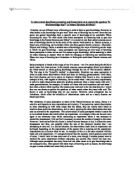“We see and understand things not as they are but as we are.” Discuss this claim in relation to at least two ways of knowing.
For many years, we have gradually come to understand the world around us through our senses. Indeed, our senses can be so convincing that we often hear the phrase “seeing is believing”. But can we totally rely on our senses give us the truth? After all, there are instances where we saw or heard things that weren’t there at all. This in turn raises questions concerning our sense perception: How do we know? To what extent we experience the same reality? How do our emotions and cultural beliefs affect the way we ‘see’ and ‘understand’ the world?
To begin with, I have seen my little cousin color the sea red, grass blue or colors that do not necessary fit the object. After all, isn’t the color of the sea the color of the sea, why do we perceive it differently? The issue here is that we ‘see’ the things in the same way but conceive it differently. In fact, color is associated with light. Light at different frequencies produce different colors. However, light should not be mistaken for the experience of color. The interpretation of the physical world eventually comes down to the mind. Even before the scientific discoveries of light and wavelengths, the great German philosopher, Immanuel Kant, holds that the mind shapes our perception of the world, rather than the other way round. As opposed to British empiricist, John Locke, Kant suggests that the mind is not a tabula rasa, or a blank slate whereby experiences are subsequently written on. Rather, our mind comes equip with a priori conditions of time and space for organizing our sense impressions into some sort of order. [1] Up till this point, the a priori conditions of the mind seem to make an ideal way in the quest of objective truth.
However, there is a difference between sense impression of the world and the intellectual conception of the world. Kant brings his ideas further by saying that subjecting our perceptions to the category of intuition is not enough to give us an understanding of the world. Understanding must be accompanied with concept which identifies the common and universal characteristics about the representation of the perceived object. Using reason, we recognize recurring patterns and make generalization to give us an understanding of the world. However, our understanding is often subjected to our judgments. Without judgments, it would not be possible for us to experience the object. For instance, being an international student, I am exposed to different people of different cultural background. Though everyone is unique in their own sense in terms of appearance and character, I tend to generalize that all Koreans are good in math since this holds true based on my experiences. In this case, judgments are imposed on my perception on others. This can be misleading as it is only my understanding of the Koreans. Thus, perception can sometimes be deceptive since what we ‘understand’ is not solely determined by what is ‘out there’, but rather by our mental and physical make up. 1 This understanding is said to be a subjectivist’s point of view.








